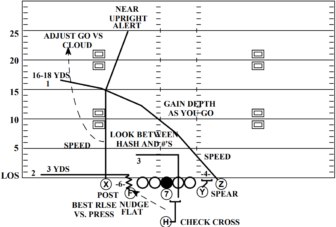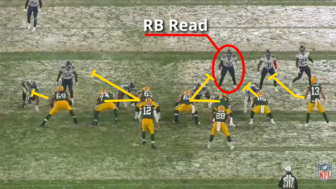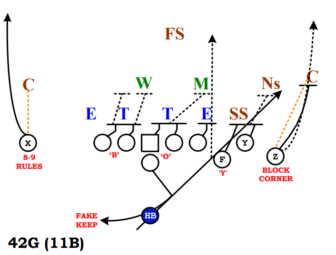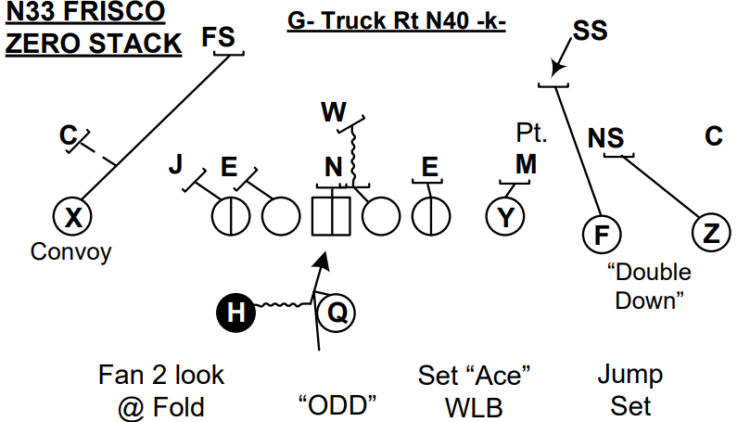
Draw is a run play that disguises itself as a pass. The offensive line is setting up the defense with pass sets and the quarterback is taking a drop before either handing the ball off or the quarterback running themselves. It’s a great change-of-pace play for obvious pass downs or when the defense is playing loose in coverage.
Yankee Concept
Draw Philosophy
Draw is based on deception and forcing the defense into their pass drops. The offensive line will pass set with an emphasis on driving defenders up and out to create space in the middle of the field. One of the interior linemen will then climb to the second level to get onto a linebacker and create a lane for the ballcarrier. It can be run out of multiple formations, with lead blocks from fullbacks, and even with the quarterback running the ball themselves. The receivers will run clear out routes to remove pass defenders.

Draw Assignments
Multiple players can end up being the ball carrier on Draw. In that case, they take the assignment of the running back. Teams will also change who climbs to the second level based on front, alignment, or personnel ability.
Quarterback:
- Opens to the play-side with eyes downfield
- Gives ball to running back at the top of their drop and continues pass fake with eyes and shoulders
Running Back:
- Shuffle to A-gap and sell a scan for pass protection
- Receive handoff and read the defensive lineman shaded over the nose or the first defender to the play-side
- On quarterback draws, running backs will be involved in the blocking scheme
- Running backs will typically insert away from the play-call to the second level defender to prevent them from scraping and chasing
Sail Concept
Offensive Line:
- Play-side Tackle (PST)
- Pass set with aiming point at the inside number of edge rusher
- Wash up and out to clear them from vertical seams inside
- Play-side Guard (PSG)
- When on the side of the nose defender, they will pass set and combo with the center
- If the player goes onto the center, they will climb to the second level
- If the player stays on the guard, they will wash them in the direction that the defender wants to go
- The center will then climb to the second level
- When the PSG is not to the side of the nose defender, they will be responsible for pass setting and washing any 3-tech or B gap defender
- Regardless of direction or spike, they must carry them out of the play
- When on the side of the nose defender, they will pass set and combo with the center
- Center (C)
- The center will work the nose defender
- If they stay engaged, the center will carry them out of the play
- If the defender moves onto the guard, the center will climb to the second level
- The center will work the nose defender
- Backside Guard (BSG)
- When on the side of the nose defender, they will pass set and combo with the center
- If the player goes onto the center, they will climb to the second level
- If the player stays on the guard, they will wash them in the direction that the defender wants to go
- The center will then climb to the second level
- When the BSG is not to the side of the nose defender, they will be responsible for pass setting and washing any 3-tech or B gap defender
- Regardless of direction or spike, they must carry them out of the play
- When on the side of the nose defender, they will pass set and combo with the center
- Backside Tackle (BST)
- Pass set with aiming point at inside number of edge rusher
- Wash up and out to clear them from vertical seams inside
As a general rule, if there is a player in an offensive lineman’s outside gap, they must attach to that player and wash them out of the play.
Duo Concept
Examples
The Colts are running a running back draw with a tight end insert to the play-side. Every lineman that has a player in their outside gap must move that player out of the inside vertical run lanes. The center and guard that are to the side of the defender over the center are the ones critical to the play. The left guard takes a short pass set to prevent any blitz or spike by the backside defensive end. When that doesn’t happen, he helps chip the nose defender onto the center on his way to the backside inside linebacker. His job is to get square on that player and let the running back read the linebackers movement. The tight end meanwhile is immediately climbing and getting square on the play-side linebacker.
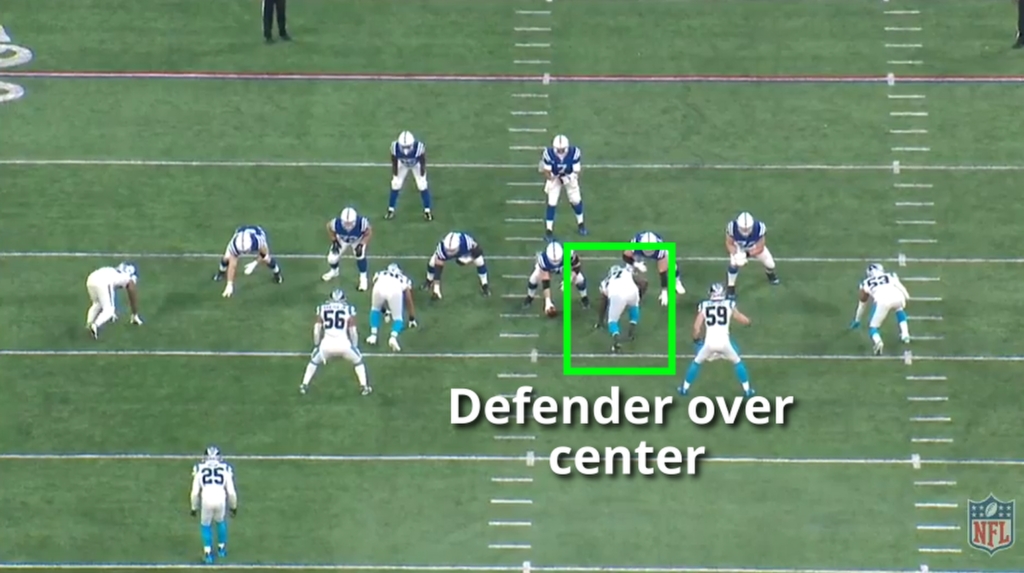
The quarterback takes a quick pass set and the running back shuffles to the A-gap. He is reading the defender over the center, who takes an outside track. After that, he just has to be patient enough for his BSG to get onto the linebacker and make a cut off of their block.
Teams will often run quarterback draws out of empty formations to spread out the defense and remove a player from the box. That’s what the Bills do here by motioning the running back out of the backfield right before the snap. That also takes a linebacker with them. Again, all the lineman with a defender in their outside gap wash them out of the play. The center and right guard are working on the nose defender with their eyes on the remaining linebacker. When the defender over the center engages with the guard, the center is now clear to climb to the second level. The quarterback takes a quick pass set to read the running back motion and then takes off on the draw.
Here is a good example from the Colts of what happens when defensive linemen spike or slant. Remember, offensive lineman have to carry players out of the vertical running lanes. If they spike, they need to continue to wash them. Here, the 3-technique over the left guard spikes inside. The guard then washes them the direction that they spike in. The nose defender also slants inside towards the center. That allows the PSG to push them onto the center and climb to the linebacker themselves. The running back shuffles as the quarterback keeps his eyes up and gives a pump to hold defenders away from the play-side.
Outside Zone
Summary
Draw is a great change of place play that almost every offense at every level has in their playbook. It can neutralize aggressive pass rushers and wash them out of their run responsibility. It also attacks defenses that are quick to bail to their pass assignments. It’s best on obvious passing downs. Draw isn’t a bread-and-butter play and usually only gets run once or twice a game.

